Tree Hive |
||||||||||||||||||||||||||||||||||
 |
 |
|||||||||||||||||||||||||||||||||
Crocheted jacket in DROPS Sky. Piece is crocheted top down with round yoke , puff stitches and relief treble crochets. Size: S - XXXL
DROPS 218-19 |
||||||||||||||||||||||||||||||||||
|
------------------------------------------------------- EXPLANATION FOR THE PATTERN: ------------------------------------------------------- CROCHET INFO: Replace first treble crochet on row with 3 chain stitches. Replace first double crochet on row with 1 chain stitch. CHAIN STITCH: If you work at the end of crochet hook the chain stitch will often be too tight 1 chain stitch should be just as long as 1 double crochet/treble crochet/double treble crochet is wide. PATTERN: See diagrams A.1, A.2 and A.3. 1 PUFF STITCH: Work as follows in same chain stitch (it is important to work in the stitch and not around it): * Make 1 yarn over, insert hook through chain stitch, make 1 yarn over and pull through chain stitch, pull both yarn overs the same length (to avoid small and dense puff stitches it is important to pull the yarn overs long, i.e. Approx. 2 cm) *, work from *-* 5 times in total, make a yarn over and pull yarn through all loops on hook. INCREASE TIP-1 (evenly): To calculate how to increase evenly, use the total number of stitches on row (e.g. 88 stitches), minus bands (e.g. 10), and divide the remaining stitches by number of increases to be done (e.g. 42) = 1.9. In this example increase in approx. every other stitch, increase by working 2 double treble crochets in 1 double crochet, or 3 treble crochets around a chain stitch (instead of 2). NOTE! Do not increase over stitches in bands. INCREASE TIP-2 (applies to sides of body): Increase 1 stitch by working 2 stitches in same stitch. Increase on each side of marker as follows: Work until 2 stitches remain before marker thread, increase 1 stitch in next stitch, work 2 stitches (marker thread is in the middle of these 2 stitches), increase 1 stitch in next stitch (= 2 stitches increased at the marker thread and 4 stitches increased in total on row). WORK 2 DOUBLE CROCHETS TOGETHER: * Insert the hook through the next stitch, pick up the strand *, work from *-* a total of 2 times, make 1 yarn over and pull it through all 3 loops on the hook (= 1 stitch decreased). RELIEF TREBLE CROCHET: Work 1 treble crochet around 1 treble crochet on previous row (i.e. do not work in loops but around treble crochet) as follows: 1 yarn over (the same way as working 1 regular treble crochet), lead hook around next treble crochet on previous row (i.e. in from right side and out on left side), get the yarn, work the rest of treble crochet as usual. ------------------------------------------------------- START THE PIECE HERE: ------------------------------------------------------- JACKET - SHORT OVERVIEW OF THE PIECE: Work yoke back and forth from mid front, top down. Now divide yoke for body and sleeves. Work body back and forth, top down. Work sleeves back and forth, top down (work sleeves back and forth to get the same texture as on body). YOKE: Work 89-89-95-101-107-107 CHAIN STITCHES - read explanation above, on hook size 4.5 mm with 1 strand Sky. Work first row as follows from wrong side: Work 1 double crochet in 2nd chain stitch from hook, work 1 double crochet in every chain stitch the rest of row = 88-88-94-100-106-106 double crochets on row. Work next row as follows from right side: Work A.1 over the first 5 stitches, work A.2 until 11 stitches remain on row (= 12-12-13-14-15-15 repetitions of 6 stitches), and finish with A.3 over last 11 stitches. Continue pattern back and forth like this. REMEMBER THE CROCHET TENSION! AT THE SAME TIME on every row marked with arrow, increase stitches evenly as explained below - read INCREASE TIP-1: Arrow-1: Increase 42-48-42-48-48-48 double treble crochets evenly = 130-136-136-148-154-154 stitches (there is now room for 19-20-20-22-23-23 repetitions of A.2 in width). Arrow-2: Increase 36-42-42-48-48-48 double treble crochets evenly = 166-178-178-196-202-202 stitches (there is now room for 25-27-27-30-31-31 repetitions of A.2 in width). Arrow-3: Increase 36-42-42-42-36-42 treble crochets evenly = 202-220-220-238-238-244 stitches (there is now room for 31-34-34-37-37-38 repetitions of A.2 in width). Arrow-4: Increase 28-26-30-42-36-42 treble crochets evenly = 230-246-250-280-274-286 stitches. When A.1 to A.3 have been worked, work A.1 to A.3 x, AT THE SAME TIME increase evenly every time row with double treble crochets is worked, increase 0-0-12-13-11-13 double treble crochets evenly 0-0-2-2-4-4 times = 230-246-274-306-318-338 stitches. Continue with A.1 to A.3 x until piece measures 20-23-25-28-30-33 cm, finish with a row with double treble crochets. Now divide yoke for body and sleeves, i.e. work next row as follows – read CROCHET INFO: Work 1 double crochet in each of the first 37-40-44-48-51-55 stitches (= front piece), work 6-6-6-6-8-10 loose chain stitches (= in the side under sleeve), skip the next 46-48-54-62-62-64 stitches (= sleeve), work 1 double crochet in each of the next 64-70-78-86-92-100 stitches (= back piece), work 6-6-6-6-8-10 loose chain stitches (= in the side under sleeve), skip the next 46-48-54-62-62-64 stitches (= sleeve), and work 1 double crochet in each of the remaining 37-40-44-48-51-55 stitches (= front piece). Finish body and sleeves separately. NOW MEASURE THE PIECE FROM HERE! BODY: = 150-162-178-194-210-230 stitches (including the 6-6-6-6-8-10 chain stitches under each sleeve). Insert 1 marker thread 40-43-47-51-55-60 stitches in from each side (= 70-76-84-92-100-110 stitches between marker threads on back piece). Move marker threads upwards when working. Use them later when increasing in the sides. Continue back and forth with A.1 to A.3x as before. When body measures 4 cm from division, increase 2 stitches in each side - read INCREASE TIP-2. Increase like this every 9 cm 3 times in total in each side = 162-174-190-206-222-242 stitches. Work until body measures 28-27-27-26-26-25 cm from division, but finish after 1 row with double treble crochets. Then work as follows: * 1 treble crochet, 1 RELIEF TREBLE CROCHET - see explanation above *, repeat from *-*. Work treble crochet in treble crochet and relief treble crochet in relief treble crochet until piece measures 32-31-31-30-30-29 cm. Fasten off. Jacket measures approx. 56-58-60-62-64-66 cm from shoulder and down. SLEEVE: Work sleeves back and forth from mid under sleeve (to get the same texture on body and sleeves). Begin from wrong side, in the middle of the 6-6-6-6-8-10 stitches under sleeve, and work 1 double treble crochet in each of the 3-3-3-3-4-5 stitches from the middle and out, work 1 double treble crochet in each of the 46-48-54-62-62-64 stitches that were skipped, and finish with 1 double treble crochet in each of the last 3-3-3-3-4-5 stitches mid under sleeve = 52-54-60-68-70-74 stitches, turn piece. Continue back and forth with A.1 to A.3x as before. When piece measures 3 cm from division, decrease 1 stitch in each side as follows: WORK 2 DOUBLE CROCHETS TOGETHER – read description above, work until there are 2 stitches left on round, work 2 double crochets together. Decrease like this every 7-6½-4-2½-2½-2 cm 6-6-8-12-12-13 times in total in each side= 40-42-44-44-46-48 stitches. Continue until piece measures 41-39-37-35-34-32 cm, finish after 1 round with double treble crochets. NOTE! Shorter measurements in the larger sizes because of wider neck and longer yoke. Then work as follows: * 1 treble crochet, 1 RELIEF TREBLE CROCHET - see explanation above *, repeat from *-* the entire row. Work treble crochet in treble crochet and relief treble crochet in relief treble crochet until piece measures 45-43-41-39-38-36 cm. Fasten off. Work the other sleeve the same way. ASSEMBLY: Sew underarm seams – sew in outer loops of edge stitch. Place buttons evenly on left front piece and fasten, button between 2 treble crochets in band on right front piece. |
||||||||||||||||||||||||||||||||||
Diagram explanations |
||||||||||||||||||||||||||||||||||
|
||||||||||||||||||||||||||||||||||

|
||||||||||||||||||||||||||||||||||

|
||||||||||||||||||||||||||||||||||
|
Have you made this or any other of our designs? Tag your pictures in social media with #dropsdesign so we can see them! Do you need help with this pattern?You'll find tutorial videos, a Comments/Questions area and more by visiting the pattern on garnstudio.com. © 1982-2024 DROPS Design A/S. We reserve all rights. This document, including all its sub-sections, has copyrights. Read more about what you can do with our patterns at the bottom of each pattern on our site. |
||||||||||||||||||||||||||||||||||







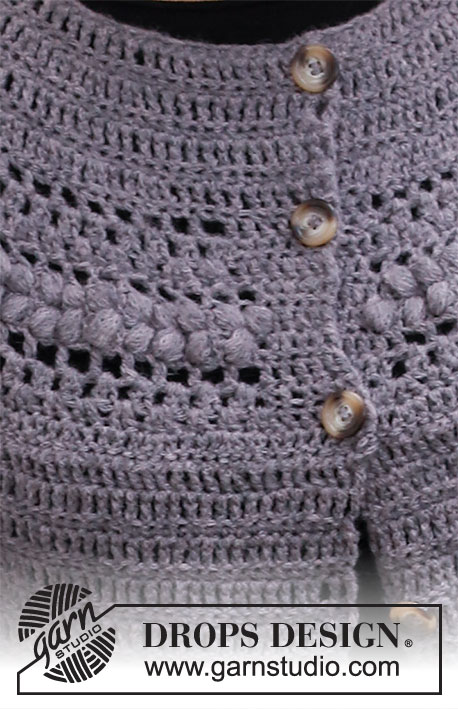

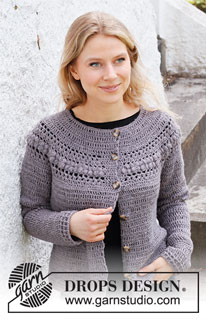
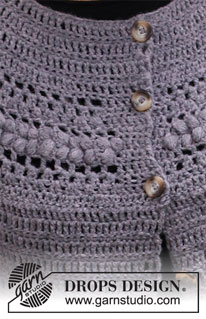
















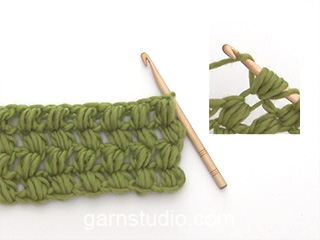

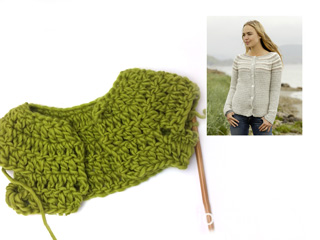

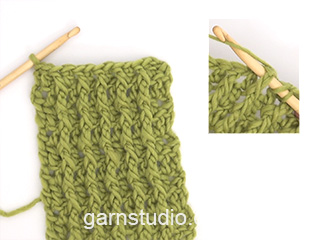




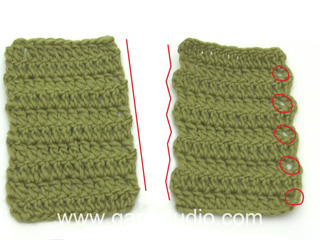


























Comments / Questions (4)
Arrow-3: Increase 36-42-42-42-36-42 double crochets evenly = 202-220-220-238-238-244 stitches (there is now room for 31-34-34-37-37-38 repetitions of A.2 in width). Don't get the last part in brackets and Arrow 3 am guessing is Row 3.
25.03.2022 - 02:04DROPS Design answered:
Dear Lilian, Arrow-3 is the arrow with number 3 in the right side of the A.1 diagram. The part in brackets means that after the increases, in the next row you will be able to work A.2 the number of times indicated, depending on the size. Happy crochetting!
26.03.2022 - 19:47Vol enthousiasme ben ik begonnen aan dit vestje. Ik loop vast bij de kussensteken; het lukt mij niet om kussensteken voorlangs een stokje te krijgen en dus een soort terug te gaan in de rij zodat het stokje schuin gaat. Ik heb nu een aanpassing gedaan met kussensteek -losse, stokje, losse en dan weer kussensteek. Dat komt qua steken prima uit maar lijkt niet zo op het origineel. De kussensteken an sich lukken prima, en het staat ook wel oké, maar het oogt minder dicht dan op het voorbeeld.
01.10.2021 - 16:41DROPS Design answered:
Dag Annemarie,
Heb je de video bekeken over de kussensteek? Misschien moet je de lussen wat minder hoog ophalen, zodat de kussensteek wat strakker wordt
02.10.2021 - 10:25Hallo, Ich verstehe nicht wie ich nun mit den Rumpfteil häkeln soll. Wie lang sollen die Markierungsfaden sein?
25.09.2021 - 14:28DROPS Design answered:
Liebe Frau Böhm, dieses Video zeigt, wie man einen Markierungsfaden benutzt, wenn ich so Markierungsfäden benutze sind meine ca 20-30 cm, ob es Ihnen helfen kann. Sie können auch Maschenmarkierer benutzen. Viel Spaß beim häkeln!
27.09.2021 - 08:03Non riesco a capire quando devo iniziare a lavorare il dietro e il dvanti separatamente
04.11.2020 - 16:01DROPS Design answered:
Buongiorno Lucia, non si lavorano il davanti e il dietro in modo separato. Segua semplicemente le istruzioni. Buon lavoro!
04.11.2020 - 19:07